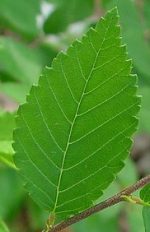 Siberian elm is semi-evergreen to deciduous tree growing up to 70’ tall native to northern India and China, Siberia, Mongolia, Tibet, Russian Far East and Korea. It was introduced into the US in 1905 and later selected by the USDA for use in shelter belts after the Dustbowl because of its rapid growth and tolerance for drought and cold. In the 1950s it was embraced as a fast-growing hedge for use instead of privet and it naturalized in many area becoming invasive in most of North America south of the boreal forest. The tree is considered a poor as ornamental because of its tendency to be short-lived, poor crown shape, high susceptibility to pests and disease, and brittle wood that breaks easily in wind or snowfall. USDA Hardiness zones 4-9
Siberian elm is semi-evergreen to deciduous tree growing up to 70’ tall native to northern India and China, Siberia, Mongolia, Tibet, Russian Far East and Korea. It was introduced into the US in 1905 and later selected by the USDA for use in shelter belts after the Dustbowl because of its rapid growth and tolerance for drought and cold. In the 1950s it was embraced as a fast-growing hedge for use instead of privet and it naturalized in many area becoming invasive in most of North America south of the boreal forest. The tree is considered a poor as ornamental because of its tendency to be short-lived, poor crown shape, high susceptibility to pests and disease, and brittle wood that breaks easily in wind or snowfall. USDA Hardiness zones 4-9
The following native are recommended as alternatives:
Sugarberry (Celtis laevigata)
Growing to 80’ tall, sugarberry is a deciduous shade tree native to lowlands of eastern US west to Texas and south to northeastern Mexico. USDA Hardiness zones 6-9
Hackberry (Celtis occidentalis)
Growing up to 80’ tall, hackberry is a deciduous tree native to floodplains, rocky uplands, waste sites, and roadsides from Quebec to Manitoba and North Dakota, south to Florida and new Mexico. USDA Hardiness zones 2-9
Kentucky Coffeetree (Gymnocladus ioica)
Kentucky coffeetree is a deciduous tree growing 80-100’ tall and has very large tripinnate leaves, insignificant flowers, and large mahogany-colored seedpods that can be a litter problem along with the leaves in the fall. It is native to woodlands, floodplains, old fields, and clearings from New York to Minnesota, south to Virginia, South Dakota, and Oklahoma but has naturalized elsewhere. USDA Hardiness zones 4-8
Osage Orange (Maclura pomifera)
Growing up to 60’ tall, osage orange is a spiny deciduous tree or shrub native to river valleys and rich bottomlands in Arkansas, Oklahoma, Texas and Louisiana but has been planted in many places in the US and has naturalized. Extensively used as a hedgerow in the past. USDA Hardiness zones 4-9
Hop Hornbeam (Ostrya virginiana)
This understory deciduous tree grows up to 40’ tall and is native to dry soils from Nova Scotia to southern Manitoba and eastern Wyoming, southeast to Florida, and southwest to eastern Texas. It has attractive and unusual fruits that resemble hops.USDA Hardiness zones 3-9
Winged Elm (Ulmus alata)
Easily identified by the broad corky wings on the branchlets, winged elm is a deciduous tree growing up to 80’ feet and native open woods, floodplains, rocky slopes, and dry uplands from Maryland to Kansas, south to Florida and Texas. USDA Hardiness zones 5-9